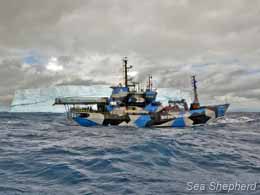Sea Shepherd are reporting that the Japanese whaling fleet is heading home, with the season coming to an end with weather starting to worsen. Sea Shepherd have again been effective in reducing the lethal efficiency of the illegal Japanese commercial whaling operation that uses a scientific loophole in the International Whaling Commission that allows them to slaughter whales for 'research' and sell the meat as part of their commercial operation.
This year it was alledged the whaling operation received substantial Government funding from monies raised in the wake of the tsunami and nuclear catastrophe that hit Japan in March 2011.
“Once Captain Peter Hammerstedt and his crew on the Bob Barker closed in on the Nisshin Maru on March 5th, the whaling season was effectively over for the season,” said Captain Paul Watson on the Sea Shepherd flagship Steve Irwin recently returned and now berthed in Williamstown, Victoria, Australia.
Captain Peter Hammarstedt of the Sea Shepherd MY Bob Barker said that the fleet has left the waters of the Southern Ocean Whale Sanctuary heading steadily northwestward. A final few hours of conflict between the Bob Barker and two whaling harpoon ships erupted at night on March 5 with the Japanese vessels crossing the bows of the Bob Barker with tow lines deployed in an effort to foul the Sea Shepherd's propellors. Both Sides also used blinding spotlights, and Sea Shepherd used laser lights and fired flares for the Japanese ships to keep their distance.
Sea Shepherd has reported that fishing vessels at thirty degrees South, which is due east of Brisbane, Australia have sighted the Japanese government security vessel, Shonan Maru #2, well on its way back to Japan.
“The kill figures will not be released by Japan until April, but in my opinion they will not get over 50% for certain and my prediction is it will not be above 30%. Not as good as last season, but much better than all the previous years.” Said Captain Paul Watson. “It has been a successful campaign. There are hundreds of whales swimming free in the Southern Ocean Whale Sanctuary that would now be dead if we had not been down there for the last three months. That makes us very happy indeed."
For most of this whaling season Sea Shepherd had two operational boats - the Steve Irwin and the Bob Barker. A third sea sheperd vessel, the Brigitte Bardot, was forced to retire early in the whaling season when it sustained damage from a rogue wave and returned to Fremantle, Western Australia for structural repairs.
The whaling fleet were located on Christmas Day, relatively early in the whaling season, by the use of drones. Shortly after the Brigitte Bardot returned to Fremantle accompanied by the Steve Irwin and shadowed by the Shonnon Maru 2. Three forest rescue activists boarded the Japanese security ship in an attempt to delay it following the Steve Irwin. The three Australians held captive on board the security ship heading for Antarctica elicited a diplomatic crisis which eventually resulted in an Australian Customs vessel rendezvous with the Shonan Maru to remove the three Australians.
Sea Shepherd are threatening to return next season in a new campaign called Operation Cetacean Justice with four ships, two helicopters, four UAV (drones), and 120 volunteers.
Captain Paul Watson concluded “If the Japanese whalers return, Sea Shepherd will return. We are committed to the defense of the Southern Ocean Whale Sanctuary.” Said Captain Paul Watson. “No matter how long it takes, no matter how risky or expensive. The word “sanctuary” actually means something to us and that something is worth fighting for.”
Image: The Bob Barker making its way through the Southern Ocean Whale Sanctuary. Photo: Carolina A. Castro

